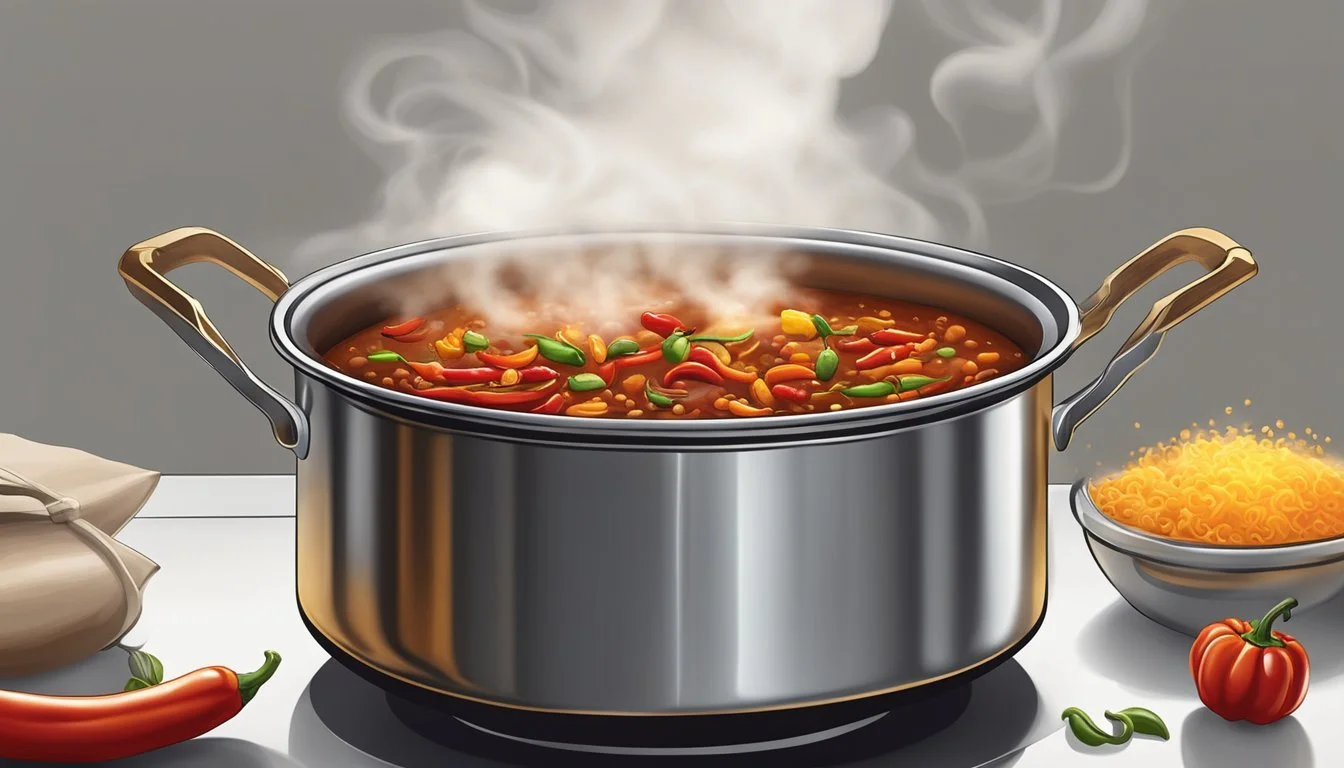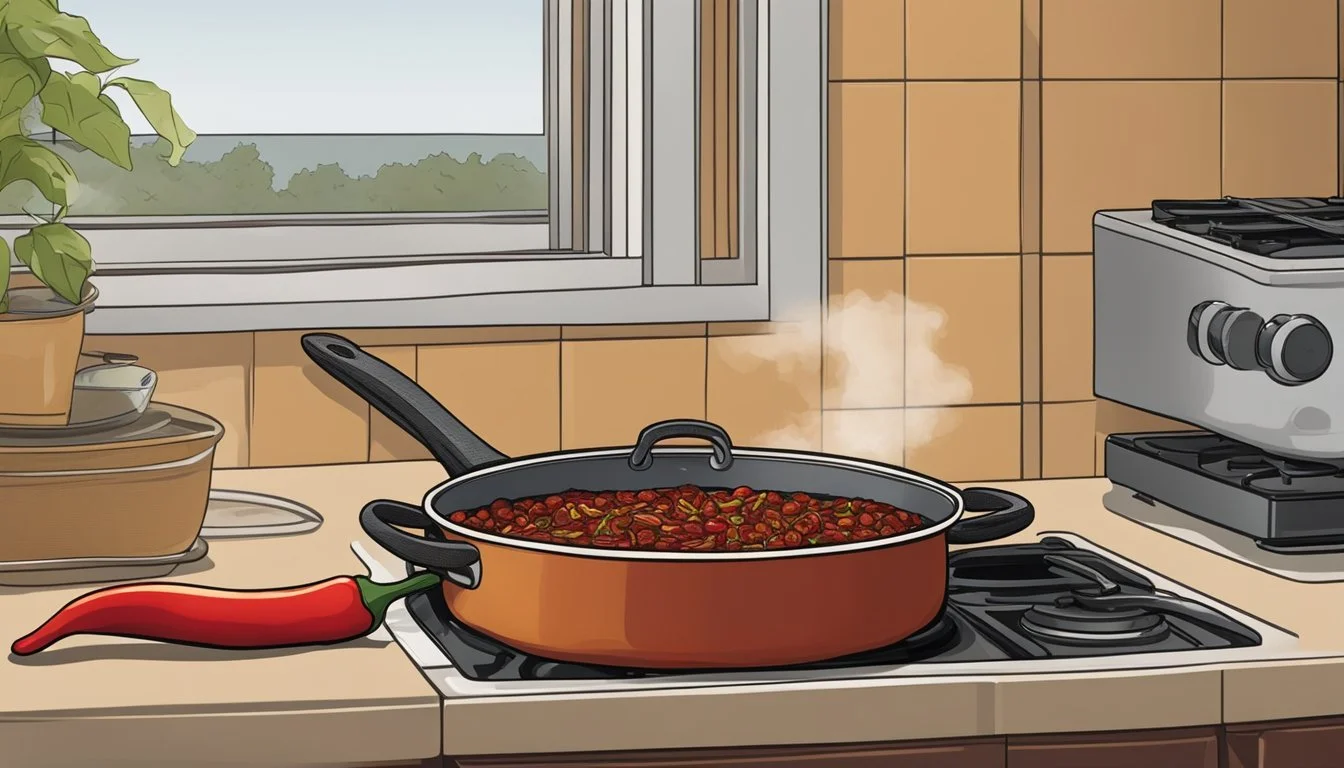How Long Does Chili Last?
Storage Tips and Safety Guidelines
Chili is a delicious and versatile dish that many enjoy year-round, but knowing how long it lasts is crucial for maintaining food safety and flavor. Chili generally lasts for 3 to 4 days in the fridge without undergoing any significant changes to its taste or texture. Whether it's meat-based or vegetarian, proper storage is essential to ensure that it remains safe to eat.
Several factors impact the shelf life of chili, such as the ingredients used and how quickly it is refrigerated after cooking. Meat-based chili tends to spoil slightly faster than its vegetarian counterpart. Using airtight containers and refrigerating the chili within two hours of cooking can prolong its freshness.
For those looking to extend the storage time, freezing is a viable option. Storing chili in the freezer can keep it good for up to three months. Proper labeling and airtight containers will help maintain its quality, making sure you can enjoy your chili even weeks after it was originally prepared.
Understanding Chili Preservation
Chili, a flavorful and hearty dish, requires proper preservation to maintain its quality and safety over time. Knowing how to store chili correctly can extend its shelf life and prevent spoilage.
Refrigerator Storage
Chili should be stored in the refrigerator at a temperature below 40°F (4°C). It is best to use an airtight container to keep out bacteria and prevent odor contamination. In the fridge, chili can last for 3 to 4 days.
Canned Chili
Canned chili is designed for longer shelf life due to preservatives. Before consumption, inspect the can for signs of spoilage, such as bulging or dents. Unopened canned chili can last for years when stored in a cool, dry place.
Freezing Chili
Freezing chili is another effective method for long-term preservation. Place the chili in airtight containers or freezer bags, leaving some space for expansion. Frozen chili can last for 4 to 6 months.
Temperature and Safety
Always reheat chili to an internal temperature of 165°F (74°C) to ensure safety. This helps kill any potential bacteria. Avoid keeping chili in the "danger zone" (40°F to 140°F) for extended periods, as this promotes bacterial growth.
Preventing Spoilage
Proper storage conditions are crucial to prevent spoilage. Keep chili away from direct sunlight and heat sources. When in doubt, discard chili that shows any signs of spoilage, such as mold, off smells, or unusual texture.
Following these guidelines ensures that your chili remains safe and delicious for as long as possible.
Impact of Ingredients on Chili's Shelf Life
Different ingredients in chili can significantly affect its shelf life. The type of chili, whether meat-based or vegetarian, along with the specific ingredients used, plays a crucial role in determining how long the chili remains safe to consume.
Meat-Based vs. Vegetarian Chili
Meat-based chili typically includes beef, chicken, pork, or steak, which can shorten its shelf life. Cooked meat-based chili generally lasts 3-4 days in the refrigerator if stored properly. The presence of meat increases the risk of bacterial growth, making it essential to consume it within a few days.
Vegetarian chili, on the other hand, doesn't contain meat and typically has a slightly longer shelf life. Ingredients like beans, tomatoes, onions, and garlic are less prone to spoilage, allowing vegetarian chili to last 4-5 days in the fridge. However, if dairy is added, it should be consumed within a similar timeframe to meat-based chili.
Common Ingredients and Their Effects
Beans are a staple in both meat-based and vegetarian chili. They are relatively stable and do not significantly impact the overall shelf life. Proper cooking and storage are vital to keep them fresh.
Tomatoes, whether diced or in sauce form, are acidic and can help prolong the freshness of chili. The acidity slows down bacterial growth, slightly extending shelf life.
Onions and garlic add flavor and depth to chili but do not drastically affect shelf life. They must be cooked thoroughly and stored correctly to maintain freshness.
Chili powder and spices not only add flavor but also possess natural preservative properties. They slow bacterial growth, indirectly aiding in extending the chili’s shelf life.
Chili peppers can vary in moisture content. High moisture levels can shorten the shelf life, so careful storage is essential.
Each of these ingredients contributes differently to how long chili remains safe to eat. Proper storage in airtight containers and maintaining a steady refrigeration temperature is crucial for both meat-based and vegetarian chili.
Optimal Storage Methods
Proper storage can extend the shelf life of chili while maintaining its taste and quality. Both refrigeration and freezing are effective methods, each providing different timeframes for safe consumption.
Refrigerating Chili
To refrigerate chili, place it in airtight containers. This minimizes exposure to air, slowing bacterial growth. Chili stored this way typically lasts 3 to 5 days.
It’s crucial to ensure the refrigerator's internal temperature remains below 40°F (4°C). Failure to maintain this temperature can lead to faster bacterial growth, reducing the chili’s lifespan.
When reheating refrigerated chili, ensure it reaches an internal temperature of 165°F (74°C) using a stovetop or microwave to kill any potential bacteria. Stir the chili occasionally while reheating to distribute the heat evenly.
Freezing and Thawing Guide
For long-term storage, freezing chili is recommended. Portion the chili into heavy-duty freezer bags or airtight containers to avoid freezer burn, and label them with the date for tracking.
Frozen chili maintains quality for 4 to 6 months. To thaw, transfer the chili from the freezer to the refrigerator and leave it for 24 hours. For quicker thawing, use the microwave's defrost setting.
When reheating thawed chili, it’s crucial to bring it to an internal temperature of 165°F (74°C). This can be done using a stovetop or microwave. Stir frequently during reheating to ensure even heating and to restore the chili's flavor and texture.
Identifying Spoilage
Identifying spoilage in chili is crucial to avoid consuming food that can cause illness. Key indicators of spoilage include changes in appearance, texture, and smell.
Visual and Textural Signs
The appearance of mold on chili is a clear indicator of spoilage. Mold growth can manifest as green, white, or black fuzzy spots on the surface.
Another visual sign is a change in texture. Spoiled chili often becomes slimy to the touch, indicating bacterial growth.
If the chili appears discolored or has an unusual appearance, it’s best to discard it. Cross-contamination can also result in visual cues, so always use clean utensils to prevent contamination.
To sum up, pay close attention to mold, slimy texture, and discoloration when inspecting chili for spoilage.
Olfactory Indicators
A foul odor is one of the most reliable signs that chili has gone bad. Spoiled chili typically emits a rancid or sour smell.
Even a slight off-odor should prompt you to discard the chili, as it indicates bacterial or mold activity.
Sometimes, the chili might still look fine but develop a strange smell. Trust your sense of smell and avoid tasting chili that smells off.
Olfactory indicators are often the first sign of spoilage, making them crucial in identifying unsafe food.
Safety Guidelines
When storing and consuming chili, ensuring safety and maintaining quality is crucial. Key elements include proper procedures for reheating stored chili and best practices for its consumption.
Reheating Stored Chili
Reheating chili properly is essential to avoid foodborne illness. Ensure the chili is heated to an internal temperature of at least 165°F (74°C). Use a food thermometer to verify this temperature. Stir the chili frequently while reheating to ensure even heat distribution.
If reheating in a microwave, cover the chili to retain moisture and prevent splatters. Let it stand for a few minutes after microwaving to allow the heat to distribute evenly. For stovetop reheating, use a pot and keep stirring until it reaches the safe temperature. Make sure to reheat only once to preserve flavor and quality.
Consumption Best Practices
Consume refrigerated chili within 3 to 4 days for optimal safety. For frozen chili, aim to use it within 4 to 6 months. Always err on the side of caution; if there are signs of spoilage, such as an unusual odor or appearance, discard the chili.
Store leftover chili in airtight containers to prevent contamination. Label the containers with dates to monitor their storage duration. When serving leftover chili, ensure it remains hot during consumption, maintaining a temperature above 140°F (60°C) to prevent the growth of harmful bacteria.
By following these safety guidelines, the risk of foodborne illness is minimized, and the quality of the chili remains high.
Maximizing Chili Quality Over Time
To ensure your chili retains its taste and texture, focus on proper seasoning and toppings, and take measures to avoid freezer burn when storing it. These steps will help maintain the flavor and freshness of your spicy stew.
Proper Seasoning and Toppings
The use of fresh seasonings like cumin, cinnamon, and chili powder can enhance the taste of homemade chili or chili con carne. Adding the right amount of spices not only intensifies the flavor but also helps to preserve the dish's quality over time. Cumin and cinnamon mix well with chili powder to produce a rich, savory flavor.
When preparing leftover chili, consider incorporating fresh toppings such as sour cream, cheese, jalapeños, and a variety of vegetables. These toppings not only elevate the taste but also introduce new textures, making the dish feel freshly made. For a Texas-style chili, use a combination of cheese and jalapeños for an added kick.
Ensuring that all ingredients, including vegetables and seasonings, are fresh, will make a noticeable difference in the overall quality. Spices like chili powder should be stored in a cool, dry place to retain their potency.
Avoiding Freezer Burn
Freezer burn can significantly diminish the quality of chili, affecting both texture and flavor. To avoid this, ensure the chili is stored in airtight containers. Removing as much air as possible from the storage bags or containers will go a long way in preventing freezer burn.
Label each container with the date to keep track of how long it has been stored. Properly frozen chili, kept at a steady temperature, can last for 4 to 6 months in the freezer without losing its quality.
Thoroughly cool the chili before placing it in the freezer. This prevents moisture build-up that can lead to freezer burn. Portioning the chili into smaller servings also helps in faster freezing, reducing the risk of ice crystal formation.
Taking these steps will help maintain the rich, spicy flavors of your chili over an extended period.
Special Considerations
When storing chili, the type of chili and the variations in its ingredients are critical to determining how long it will last and the best practices for preserving its freshness.
Type-Specific Storage Recommendations
Homemade Chili: For chili made at home, particularly with ground beef, it's best stored in an airtight container in the refrigerator. Proper cooling within two hours of cooking can extend its freshness to about 4-5 days.
Canned Chili: Canned chili has a longer shelf life due to preservatives. Unopened cans can last up to two years in a cool, dry place. Once opened, it should be transferred to an airtight container and refrigerated, where it can last for 3-4 days.
Vegetarian Chili: Lacking meat, vegetarian chili might last slightly longer. Still, similar storage guidelines apply – use airtight containers and refrigerate promptly to maintain quality.
Understanding Variations in Chili Recipes
Meat-Based Chili: Ground beef or other meats can make chili more susceptible to quicker spoilage. Store such chili with extra care, making sure it reaches refrigerator temperatures rapidly after cooking.
Leftovers: Leftover chili needs prompt refrigeration. It’s advisable to place it in shallow containers to cool quickly.
Different Flavors and Ingredients: Mild or spicy, the variety of chili influences its longevity. Spicier varieties might mask spoilage signs, so regular checks for off smells or tastes are important.
Consistent Quality: Whether cooked from fresh or stored, maintaining the quality requires attention to detail in storing conditions, like avoiding temperature fluctuations and using proper containers.








